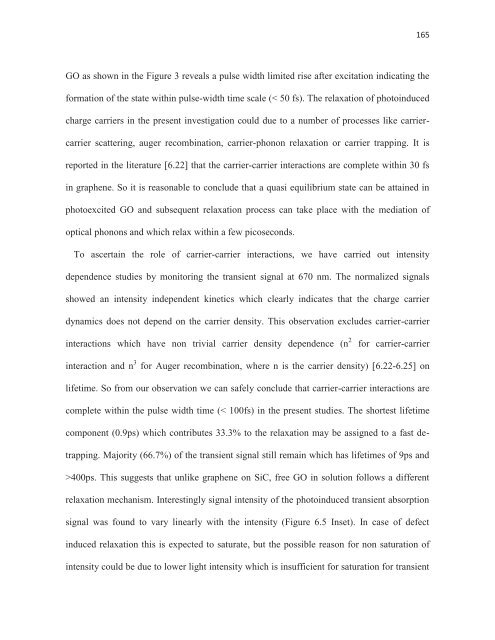CHEM01200604009 Sreejith Kaniyankandy - Homi Bhabha ...
CHEM01200604009 Sreejith Kaniyankandy - Homi Bhabha ...
CHEM01200604009 Sreejith Kaniyankandy - Homi Bhabha ...
Create successful ePaper yourself
Turn your PDF publications into a flip-book with our unique Google optimized e-Paper software.
165<br />
GO as shown in the Figure 3 reveals a pulse width limited rise after excitation indicating the<br />
formation of the state within pulse-width time scale (< 50 fs). The relaxation of photoinduced<br />
charge carriers in the present investigation could due to a number of processes like carriercarrier<br />
scattering, auger recombination, carrier-phonon relaxation or carrier trapping. It is<br />
reported in the literature [6.22] that the carrier-carrier interactions are complete within 30 fs<br />
in graphene. So it is reasonable to conclude that a quasi equilibrium state can be attained in<br />
photoexcited GO and subsequent relaxation process can take place with the mediation of<br />
optical phonons and which relax within a few picoseconds.<br />
To ascertain the role of carrier-carrier interactions, we have carried out intensity<br />
dependence studies by monitoring the transient signal at 670 nm. The normalized signals<br />
showed an intensity independent kinetics which clearly indicates that the charge carrier<br />
dynamics does not depend on the carrier density. This observation excludes carrier-carrier<br />
interactions which have non trivial carrier density dependence (n 2<br />
for carrier-carrier<br />
interaction and n 3 for Auger recombination, where n is the carrier density) [6.22-6.25] on<br />
lifetime. So from our observation we can safely conclude that carrier-carrier interactions are<br />
complete within the pulse width time (< 100fs) in the present studies. The shortest lifetime<br />
component (0.9ps) which contributes 33.3% to the relaxation may be assigned to a fast detrapping.<br />
Majority (66.7%) of the transient signal still remain which has lifetimes of 9ps and<br />
>400ps. This suggests that unlike graphene on SiC, free GO in solution follows a different<br />
relaxation mechanism. Interestingly signal intensity of the photoinduced transient absorption<br />
signal was found to vary linearly with the intensity (Figure 6.5 Inset). In case of defect<br />
induced relaxation this is expected to saturate, but the possible reason for non saturation of<br />
intensity could be due to lower light intensity which is insufficient for saturation for transient
















